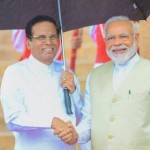The Modi government has acted swiftly to pursue its foreign policy priorities. Focused on strengthening India’s place in the world, it has begun by shoring up the country’s position in the immediate neighbourhood. This message emanated from Prime Minister Narendra Modi’s visits to the Maldives and Sri Lanka, and External Affairs Minister S. Jaishankar’s trip to Bhutan.
Ties with South Asian neighbours were a priority even earlier, as seen in the invitation extended to SAARC leaders to attend Mr. Modi’s swearing-in ceremony in 2014. After that there were some difficulties. India’s relations with Pakistan soured, while China continued to expand its footprint in Nepal, the Maldives, Sri Lanka and Pakistan. However, India’s cooperation with Bangladesh, Bhutan, Afghanistan and Myanmar showed tangible progress. As a result, attention was consciously shifted from SAARC to BIMSTEC, thereby giving an eastward shift to India’s neighbourhood policy. In 2016, BIMSTEC leaders were invited to the BRICS summit in Goa. BIMSTEC leaders also attended Mr. Modi’s swearing-in last month.
Three visits
A week thereafter, Mr. Jaishankar was in Bhutan holding comprehensive discussions with his counterpart and the Prime Minister. He also met King Jigme Khesar Namgyel Wangchuck. The visit was perhaps meant to assess the current thinking in Thimphu about Chinese overtures to open diplomatic relations and the border issue before Mr. Modi’s meeting with President Xi Jinping at the Shanghai Cooperation Organisation summit.
Mr. Modi’s visit to the Maldives was astutely designed to showcase that a dramatic turnaround has taken place in India-Maldives relations. Former Maldivian President Abdulla Yameen gave a blatantly pro-China tilt to his foreign policy. The result was that Mr. Modi had to wait until Mr. Yameen’s ouster before he could visit the Maldives in November 2018. Working in concert, the two governments have succeeded in deepening mutual understanding. While visiting India in December 2018, President Ibrahim Solih was still somewhat cautious as he spoke of balancing friends, old and new. But by the time Mr. Modi landed in the Maldives last week, Male had become more receptive. The President and the Majlis speaker reiterated the Maldives’ commitment to its ‘India first policy’. The Majlis invited Mr. Modi to deliver a special address. The President conferred the nation’s highest honour on Mr. Modi.
This visit demonstrated how India has begun to implement recent decisions to extend ample financial assistance, move ahead with projects to be funded through a new $800 million Line of Credit, and focus on people-centric welfare measures in accordance with the priorities of the Maldives. This is in sharp contrast with China’s approach of extending massive loans for mega infrastructure projects that end up in debt traps. Mr. Modi hit all the right buttons, highlighting India’s resolve to assist the Maldives in every possible manner. He identified countering terrorism, addressing climate change, and promoting an integrated and balanced Indo-Pacific as the key challenges for the region.
Mr. Modi’s visit to Colombo was prudent. It conveyed India’s solidarity with Sri Lanka as the latter struggles to overcome the overwhelming effects of the Easter Sunday attacks. Mr. Modi held discussions with all the main actors: the President, the Prime Minister, the Leader of Opposition, and Tamil leaders. President Maithripala Sirisena reflected the nation’s view as he publicly thanked Mr. Modi for a productive visit.
Policy essence
New Delhi has clearly indicated that the neighbourhood will continue to be a priority, but four subtle elements are being introduced in the policy matrix. First, without always insisting on reciprocity, India may get into a proactive mode and adopt measures “to incentivise cooperation in the neighbourhood”, as Mr. Jaishankar put it. Second, India will prefer to work on quick impact projects that bring socio-economic benefits to the people. Third, recognising its “limited capabilities”, as Foreign Secretary Vijay Gokhale disclosed, New Delhi would have no objection in forging a trilateral development partnership, involving India and Japan in a neighbouring country. Fourth, SAARC’s drawbacks have caused India’s conscious shift to BIMSTEC. Mr. Jaishankar explained that India sees a mix of “energy, mindset and possibility” in the latter grouping. The government is moving in the right direction. It could also consider bringing the Maldives into BIMSTEC, at least as an observer. Finally, Mr. Jaishankar should visit other neighbours soon, particularly Bangladesh and Myanmar.
Rajiv Bhatia is Distinguished Fellow, Gateway House, and a former Ambassador


